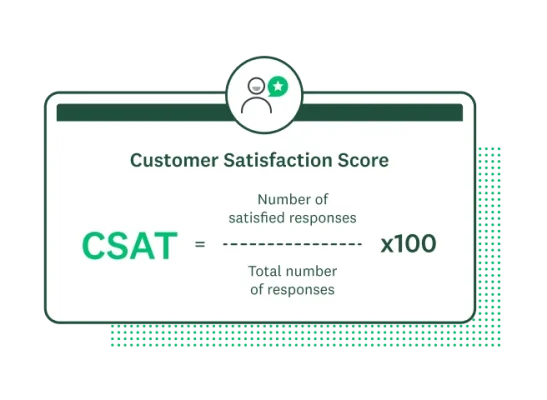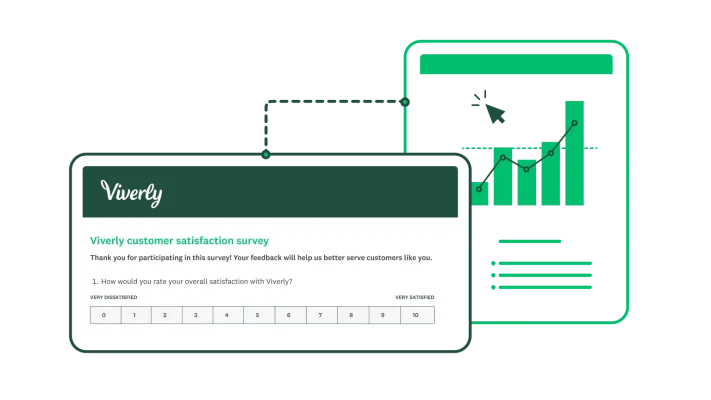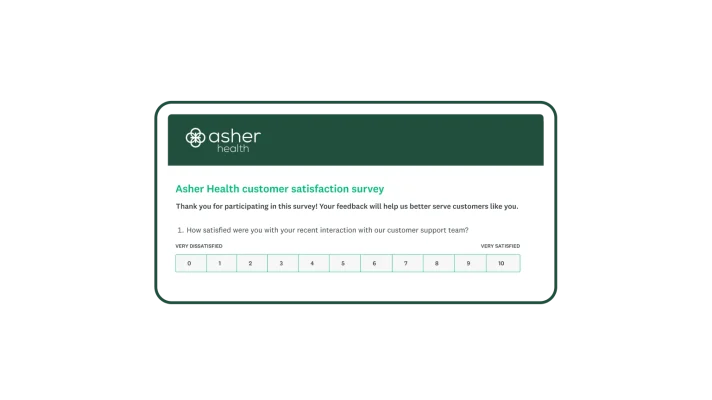Customer satisfaction surveys: Examples and tips for getting started
Learn how to write effective customer satisfaction surveys. Alternatively, create a survey in minutes with our expert-written templates and questions.

A good customer satisfaction survey does more than collect customer feedback: it builds trust and a solid relationship between you and your customers.
Keep reading to learn how to create a customer satisfaction survey that will help you improve retention and loyalty.
Customer satisfaction definition and CSAT surveys explained
Customer satisfaction measures how happy your customers are with your services, products and experiences. It assesses your ability to meet your customers’ expectations and provide them with a positive customer experience (CX). A great CX can lead to lower churn, improved revenue and a higher customer lifetime value.
One of the leading metrics for measuring customer loyalty is the Customer Satisfaction (CSAT) Score. Alongside the Net Promoter® Score (NPS®) and the Customer Effort Score (CES), the CSAT score contributes to building a valuable Voice of the Customer (VoC) programme.
To calculate your CSAT score, customers are asked to rate their overall experience with your brand. There isn’t any one specific question that you have to use as long as customers have the opportunity to rate your business on a five- or seven-point scale.

Record the number of customers who consider themselves satisfied (4 or 5 rating) out of the total number of customers and multiply by 100. This method will give you the percentage of customers who are satisfied with your company.
You can then compare this to the UK Customer Satisfaction Index (UKCSI) to benchmark your overall success.
By getting feedback on your CSAT score, you can prepare an action plan to improve your score. Over time, this can help you reduce customer churn and improve your company’s revenue.
Why are customer satisfaction surveys important?
Customer satisfaction surveys give your company the insight it needs to create a positive, refined and beneficial customer experience. It highlights areas that you can refine to create a better customer experience.
A positive customer experience is one of the most determining factors when it comes to winning return customers and building loyalty. Around 91% of customers are likely to recommend your company after a positive experience.
Equally, when done wrong, 89% of CX pros believe that a poor customer experience is the single biggest contributor to customer churn.
By understanding the factors contributing to great customer satisfaction, you can build better customer experiences. Given that every company will have different strengths and weaknesses regarding these improvements, it’s always a good idea to launch surveys that are personalised to your customers.
How to create a customer satisfaction survey

When creating a customer satisfaction survey, consider the information you want to obtain. Several customer satisfaction survey questions can help you understand distinct aspects of your customer journey.
For example, you could ask questions to understand pricing satisfaction to obtain purchase feedback:
- How satisfied are you with the pricing of our service?
- How satisfied are you with the product you received considering the price you paid?
- Do you believe that our product offers good value for the money?
Alternatively, you could look for information about overall customer satisfaction:
- What would you suggest to help us improve our product?
- Please rate your overall satisfaction with our company.
- On a scale of 1 to 10, how satisfied are you with our service?
You could even ask some customer service satisfaction questions:
- How would you rate your satisfaction with the communication you experienced from our customer support department?
- Did we manage to resolve your issue to your satisfaction?
- Please rate the helpfulness of our customer service representatives on a scale of 1 to 10.
The key to creating a great customer satisfaction survey is to start with your goal in mind. The objective of your feedback survey will determine which questions you choose to ask. Start with your goal and then customise a customer satisfaction survey template to your liking.
5 customer satisfaction survey question types
In order to obtain useful and actionable answers, you must ask the right types of questions for your customer satisfaction surveys.
Let’s explore how to use different question types to effectively measure customer satisfaction.
1. Likert scale questions

The Likert scale is a standard survey question that measures opinions with a higher degree of flexibility than a simple yes or no. This scale offers customers the option to detail their level of agreement, usually across between five and seven responses ranging from ‘Strongly Agree’ to ‘Strongly Disagree’.
Businesses can use the Likert scale to measure various sentiments, including agreement, satisfaction, desirability and frequency. For example, you might want to know how often customers use your online help portal, in which case a frequency response (i.e. Never, Rarely, Sometimes, Often, Frequently) would be useful.
Here are three examples of a customer service Likert scale survey question:
- Overall, how satisfied or dissatisfied are you with our customer service team?
- Rate your level of agreement with the following statement: “The customer service team provided by our company met your expectations.”
- How likely is it that you will recommend our company’s products based on your overall satisfaction?
Learn more about the Likert scale and how you can use it in your next survey.
2. Open-ended questions

Open-ended questions allow customers to share their thoughts and opinions for more in-depth insights and new ideas.
For example, this Market Research Survey Template starts with several open-ended questions that ask customers to list specific things they like and changes they would like to see:
- What do you like most about our new product?
- What changes would most improve our product?
- What changes would most improve competing products currently available from other companies?
Open-ended questions give respondents the freedom to answer as they please. The added flexibility of this question type can elicit useful and detailed information for your company. This question style can also provide supplementary qualitative data alongside your quantitative questions.
Create a customer satisfaction survey in minutes
Get started with our expert-written CSAT questions and create a custom survey for your business goals.
3. Nominal questions
Nominal questions are naming scales that pinpoint different categories of questions. These answers don’t have a numerical value.
In addition, the answers are not connected unless you add an option for “all of the above”.
The answers to nominal questions have no specific order; they carry significance for variable labels only.
Here are some examples of nominal questions:
- Which brands of shoes from our online store do you prefer?
- Which social media platform do you use most frequently to connect with friends?
- What is your preferred transport method for your daily commute?
Each question has a specific answer for the user that will give your company more context to their preferences and experiences.
Explore more customer satisfaction survey questions.
4. Binary questions
Binary scale questions rely on a limit of two answers per question, hence the name ‘binary’. You can present these questions as a simple yes or no or allow customers to answer with graphics such as a thumbs up/thumbs down or happy/sad face.
Here are some examples of binary scale questions:
- Did you find the products you were looking for on our website? Yes/No.
- Were you satisfied with the delivery condition of your recent order? Yes/No.
- Did you experience any technical difficulties on our website? Yes/No.
Binary questions are useful thanks to their simplicity. Customers will respond to them in a matter of seconds, thus giving them a high response rate and being a great method for obtaining quantifiable data.
Get tips on writing good survey questions.
5. Usage frequency
Usage frequency questions aim to determine how often your customers are doing a certain activity, whether that relates to using a product, visiting a physical shop or taking any other relevant action.
Here are some examples of usage frequency questions:
- How often do you use Built-Rite tools? Every day, more than once a week, a few times a month, occasionally, rarely.
- How often do you visit one of our physical stores? Every day, more than once a week, once a week, once a month.
- How frequently do you use our mobile app? Multiple times a day, once a day, a few times a week, once a week, rarely or never.
Usage frequency questions help to generate data about user behaviour. Understanding usage patterns can help your business customise its marketing efforts and personalise the user experience.
Explore best practices for creating effective surveys.
Customer satisfaction survey best practices and resources
To create a flawless customer experience, we need to listen to our customers. Taking action to remedy pain points and improve customer touchpoints will contribute to a better overall experience. Over time, this will lead to happier customers who are more loyal and likely to return to your business.
Yet around 35% of CX pros struggle to obtain the data they need from their customers. To get more information out of customers, we need to increase the average customer survey completion rate. Here are some of our top tips to increase response rates for customer satisfaction surveys:
- Keep questions concise.
- Avoid double-barrelled questions that touch on two different aspects.
- Personalise surveys and use customers’ first names.
- Leverage in-app or on-site surveys where possible.
- Send CSAT surveys after key touchpoints such as purchasing or interacting with customer service.
- Understand how to craft, launch and monitor an effective CSAT programme.
Another powerful way to get more from your customer data is to integrate your surveys with your chosen CRM. A holistic customer view will give your business a more precise overview of your customers. You can connect SurveyMonkey to Salesforce, HubSpot and other CRMs to integrate survey data automatically on the go.
Related reading: Ultimate guide to customer feedback programmes
If you’re not sure how to get started, we suggest that you take a look at our available customer satisfaction survey templates. These templates, alongside our Question Bank, will point you towards effective questions that will engage your customers. What’s more, you can benchmark many of these questions, gaining insight into how your company stacks up against others in your sector.
Looking for more info on survey-writing best practices? Check out all of our feedback survey best practices.
Improve customer satisfaction with SurveyMonkey
Measuring customer satisfaction is an important part of your business. Different types of customer satisfaction surveys help you better understand key touchpoints in the customer journey. It’s a good idea to start with a survey template or pre-written questions and then customise them for your business.
SurveyMonkey has templates, questions and resources that make it quick and easy to get reliable results. Survey your customers with confidence. Access our expert-created survey templates and tools for reliable, actionable results. Browse our catalogue of survey templates or build a survey for free.
Net Promoter, Net Promoter Score and NPS are trademarks of Satmetrix Systems, Inc., Bain & Company, Inc. and Fred Reichheld.
Discover more resources

Solutions for your role
SurveyMonkey can help you do your job better. Discover how to make a bigger impact with winning strategies, products, experiences and more.

Hornblower enhances global customer experiences
Discover how Hornblower uses SurveyMonkey and powerful AI to make the most of NPS data, collect customer insights and improve customer experiences.

Ultimate customer satisfaction guide: 8 tactics for improvement
What is customer satisfaction? Read our complete guide to discover what customer satisfaction is, how to measure it and eight strategies for business success.

A Guide to the Customer Effort Score (CES): What It Is and How to Use It
Learn how to measure customer satisfaction and experience using the customer effort score (CES). This guide explains what you need to know.